African-American socialism
African-American socialism is a political current that emerged in the nineteenth century. However, it became influential before coming to the forefront nationally. This is an economic and political theory of social organization that means the production, distribution, and exchange should be owned or regulated by the community.[1] For African Americans socialism has represented a potential for equal class status, humane treatment as laborers, and for some ideologists a means of dismantling American capitalism.[2] Black liberation is important when seeking socialism. Liberation refers to an individual being freed from imprisonment, slavery, or oppression.[3] African-Americans have not received total liberation as American citizens. The comparison of socialism among African-American individuals have had changes, but is in need of much more since the time of the Civil War and Great Depression eras. The role that media and education has played in American society has caused social problems, along with constant confusion.[4]
History of African-American Socialism
The history of African-American socialism is tied up with the writing of a socialist history of and by African-Americans. For example, when W. E. B. Du Bois wrote Black Reconstruction in America he challenged the Dunning School who had dominated American historiography of the reconstruction period with a conservative viewpoint which paid scant attention to way African-Americans had played a role in the American Civil War and the subsequent reconstruction. This approach was shared also by some European socialist writers such as Algie Martin Simons who wrote in Class Struggle in America that the anti-slavery character of the war was a myth and that the enslaved Africans played no role in their liberation.[5] This viewpoint both reflected and reinforced the failure of the Socialist Party of America to do anything but accommodate itself to the white supremacist views of the time and their embodiment in Jim Crow laws.[5] The Socialist Party of America was largely composed of European immigrants, but nevertheless this failure to engage with the reality of US race-relations contrasted sharply with that of the previous generation of migrant European radicals, such as the forty-eighters many of whom took a firm anti-slavery stance such as during the Camp Jackson affair (1861).
How African Americans Were Viewed After the Abolition of Slavery
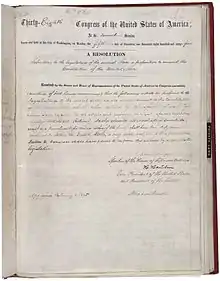
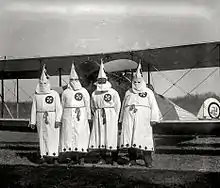
On December 6, 1865, it was ratified that the 13th amendment abolished slavery in the United States of America.[6] Because slavery had ended, there was a newfound freedom for African-Americans. However, life after slavery was different for Blacks in the North versus Blacks in the South. Because slavery was inexistent in the northern states, Blacks in the north were not affected much by the new amendment. The Southerners were finally free from brutalities and indignities of the slave life.[7] However, the post-slavery lifestyle was difficult. Although slavery was over, racism maintained. A hatred for Black people was stirred. Government throughout the South installed laws known as Black Codes. These were created to forbid freed blacks' activity and assure them the opportunity as a labor force now that slavery had ended.[8] History.com also presents information that many states forced African-Americans to sign a labor contract. If they refused, they would be arrested as vagrants.[8] This was how the Southern whites tried to suppress the newly freed African-Americans of their freedom.[9] Because the newly freed individuals did not have anything, they had to rent a portion of land from the former slave owners. This started the process of sharecropping.[7] Essentially, the former slave owners still profited from the Black population of that region. The Reconstruction period, which took place from 1865 to 1877, along with the abolishment of slavery, Congress passed two more amendments. The Fourteenth Amendment was to grant African-Americans the rights of American citizenship.[10] The Fifteenth Amendment afforded Black men the right to vote.[11] Despite the accomplishments that allows Black people in America more rights, White people gained an even stronger sense of hatred toward the people of color. Blacks were already segregated due to the Jim Crow Laws, and were unable to attend the schools and churches as their counterparts. However, the mid-nineteenth century brought about violent groups to torment the Blacks.[12] Most popular was the infamous Ku Klux Klan (KKK). This was a White supremacist group that brutally beat and murdered Blacks and other Whites who sympathized, or helped, Black people.[12]
The Rise of African American Socialism
Explicit involvement of African Americans in socialism proceeded the Civil War and the Emancipation Proclamation of 1863, as African American transitioned from the colloquial standards of enslavement to being paid laborers.[13] African American workers experienced unfair wages and unsafe working conditions, as their class status conflated with their social status as African Americans. Socialism was adopted by African Americans as socio-political-economic platform based in equality that would provide laborers with equal opportunity and pay.[14] Peter H. Clark is most often referred to as the first African American socialist. Clark was a well-established educator and associated with a number of political parties.[14] In 1877 he joined the Workingmen's Party, a socialist party that would precursor the Socialist Labor Party of America.[14] Clark vocally supported the efforts of underrepresented African American strikers in Louisville, Kentucky during the violent Great Railroad Strike of 1877.[14] As an established representative of the Workingmen's Party, Clark traveled from his hometown Cincinnati to Louisville in advocacy of the strikes and urged African Americans to support the socialist party to further the progression of their goals for fair wages and capitalist control of government. Local chapters of the Workingmen's Party in Louisville, refused to advocate on behalf of African American laborers; many were exempted from labor unions and fair wages in the aftermath of the strikes.[14]
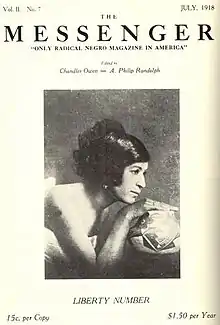
Following the Great Migration of African American's fleeing the South, and the events of World War 1 (WW1); the Harlem Renaissance acted as a catalyst for many of the radical African American socio-political movements of the early 20th century. During the 1910s the predominantly African-American populated neighborhood of Harlem, Manhattan, was home to many emerging African American activists, intellectuals, and artists that cultivated a community centered around the progression of peoples of African descent. Harlem became home to both African Americans and immigrant Afro-Caribbean and African peoples. A. Phillip Randolph and Chandler Owens are two of the most well-known socialists of the Renaissance. Most notably they began the Messenger, a radical literary magazine in 1917, which frequently featured articles advocating for African American support for socialism.[15]
The Church and Socialism
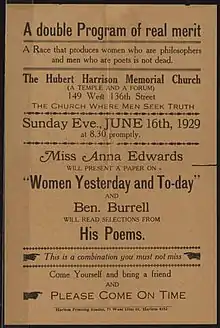
The church has emerged as a location for community organization and radicalization throughout African American history. Harlem based Reverend E. Ethelred Brown and the Los Angeles based preacher George Washington Woodbey utilized their churches as a stage to educate African Americans on Socialist ideology.[16] The Unitarian Reverend Brown arrived in Harlem from Jamaica in 1920 where he was introduced to a number of intellectual and political radicals of the time including Claude McKay and Frank Crosswaith, and indoctrinated into socialist ideology. By 1928 Brown was the Reverend of his own church, the Hubert Harrison Memorial Church, where he preached on behalf of he gave religious sermons and sermons advocating for socialism.[16] Rev. Brown believed that socialism was a logical socio-political ideology to represent his religious philosophy, and the ideals of socialism shared the same interests of African American and Afro-Caribbean peoples to attain economic and labor equality.[16] Rev. Brown was hired by the Socialist Party of America as a speaker and the Christian socialist publication World of Tomorrow as the office secretary.[16] George Washington Woodbey was a Californian minister and representative delegate of the Socialist Party of America from 1904 to 1908.[17] He believed that socialism was morally aligned with Christianity and that the problems faced by African Americans would be solved as the issues of class were solved.[17] Unlike his predecessor Peter H. Clark, and many of those who would follow him as African Americans in socialism, he did not believe in race first ideology, rather he believed in that class should be the primary concern of socialist and issues of race will be secondarily solved in the process of class equality.[17]
African-Americans and the American Socialist Party
During 1920s and 30s many African-American backers of predominantly white socialist parties such as the American Socialist Party felt disgruntled by the lack of consideration and respect from white counterparts within the organizations and abandoned Socialist ideology for Communism or Anarchism. Many African Americans engaging in socialist discourse during this period maintained both class-analysis and racial awareness. Due to their unique circumstances of racial segregation and racial violence a socialist African American could not disconnect race from class issues.[15] Hubert Harrison was hired by the American Socialist Party after criticizing its lack of African American advocacy and delegates in 1911; in 1914 he left the party due to its lack of support for peoples of color and transitioned to support the International Workers of the World. He continued to advocate as a socialist but centered his efforts around African American advocacy.[18] W.E.B. DuBois was a practicing socialist before his brief membership with the Socialists Party of America from 1911 to 1912, he left the party in support Woodrow Wilson over the party candidate Eugene V. Debs. After his egress from the party he continually criticized it for its lack of follow-through on claims of racial inequality, as many of its labor unions remained segregated.[19] A number of African-Americans involved with the Socialist Party transitioned from support to of socialism, to communism, or rejected socialism as a whole due to many of its white proprietors "class first" rhetoric.[20] Harlem radicals such as Richard B. Moore, left the party to support the more revolutionary and race-focused ideologies of communist parties.[20] Cyril Briggs another early 1900s Harlem radical, rejected joining in socialist parties, rather he asserted that African Americans and Afro-Caribbean's should adopt communist militancy to ensure they would not be ignored by the reformist principals of white upper-class led socialists organizations[21]
Not all African Americans left the Socialist Party of America after involvement, despite its "class first" rhetoric. 1922 Frank Crosswaith backed by the Party ran for Congressman of New York.[15] Crosswaith was a student of the Rand School of Social Science, a school opened by the Socialist Party of America. Crosswaith was an adamant backer of the Party, and idealized its class reformist ideologies as being ideal for African American socio-economic progression[15] Harlem activist, unionist, and politician A. Phillip Randolph joined the Party in 1916, the party would go on to financially support his radicalized magazine The Messenger, and would back him on a number of political ventures including running for comptroller and secretary of state in New York.[15] They would each remain active members of the Party late into their lives, as they went on to lead and participate in various labor and union organizations.[15]
African American Socialism Role During the Great Depression
The Great Depression of the 1930s began after the stock market crash in 1929.[12] However, it hit the Black population much harder than Whites. Black people were forced out of their already unskilled jobs. This caused them to face an unemployment rate of more that 50 percent, compared to their counterparts of about 30 percent.[22] Black workers were already being paid 30 percent below the white workers. Black people gained no relief of their trials from the Roosevelt administration because the National Recovery Act (NRA) was later referred to, by African-Americans, as the Negro Removal Act.[22] NRA public works rarely hired Blacks during this time, even though the stated goal was to not discriminate while hiring. Although the American Federation of Labor president, William Green, did acknowledge civil rights and asserted to oppose Jim Crow locations, there was nothing enforcing the affiliated unions to follow these allegations.[22] Because many Black laborers were without support, they formed unions of their own, like the Brotherhood of Sleeping Car Porters. Because these men sought their own support, they were often lynched in both the North and the South. This situation was turned around in 1934 during a strike wave.[22] Labor strikes spread all over the country from Toledo to Minneapolis to San Francisco. These events consisted of an organization among the unskilled and mass production workers, whom all were not Black. As expected during this time, racism was the center of the industrial unionism. This is a labor union organizing method in which all workers of the same industry are organized into the same union.[23] For instance, workers in the plant industry were placed into the same labor union, nationwide, regardless of an individual's particular job. Blacks, in the most dangerous, dirty and low-paid jobs, were in the same union as better-paid Whites.[22] Because of these racial injustices, African-Americans remained in the lowest ends of poverty, without legal support, throughout the years of the Great Depression.
Earliest examples
Peter H. Clark is generally recognised as the first African-American socialist. Some of his family were part of a "phalanx", a kind of commune founded by followers of Charles Fourier. He also met Thomas and Maria Varney, founders of The Herald of Truth, and Clark was employed to work as stereotypist on this paper and a sister journal, the Cincinnati Herald which was a voice for the local free soil movement.[24]
Liberation
Slavery's Influence on Prison Systems and Judicial Oppression Towards African-Americans
As stated in the Thirteenth Amendment, if an individual is convicted as a criminal, their punishment will result in involuntary servitude, or slavery. After this amendment was passed, excessively seen throughout the mid and late twentieth century, the intersection of race, justice and mass incarceration was off the charts in the United States.[25] There were imprisonment facilities present after the early English settlement in North America. However, the purpose of the facilities changed drastically as a result of political and scientific developments during the Jacksonian Era, Reconstruction Era Progressive Era, and the 1970s.
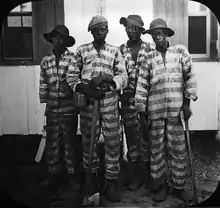
Ava DuVernay's documentary, 13th, informs viewers that the United States of America is home to five percent of the world's population. However 25 percent of people in the world are incarcerated. This film is designed to educate views that slavery has been perpetuated in this society since the end of the Civil War.[25] Citizens have witnessed this method through actions such as police arresting poor freed slaves and forcing them to work for the state under convict leasing; suppression of African-Americans by preventing them the right to register to vote in the South, along with lynchings and Jim Crow Laws; the war on drugs, presented by the conservative Republicans, which weighed heavily on minority communities, all resulting in the mass incarceration of people of color in the United States by the late 20th century.[25]
Historical documents have stated that African-Americans have been more vulnerable to criminalization than Whites from 1619 to this present day.[26] It has also been found that community resources and job opportunities have been abandoned from African-American males and females incarcerated and/or executed, also leaving their relatives in poverty and without positive role models due to the impact of criminalization on the Black community.[26] Explorations of the economic history of slavery and post-Civil War racist legislation found a way to replace the initial intent of slavery with "systems of racial control," as stated in DuVernay's documentary.[25] This started convict leasing, in the South, because Blacks were criminalized for senseless offences and could not afford to pay the fines they were disputed. This was followed by excluding Blacks from the political system, the rise of lynchings by White terrorist, and Jim Crow legislation as previously addressed.
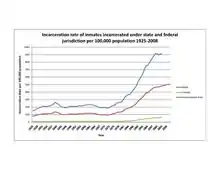
After civil rights were granted to African-Americans, the Republican Party appealed to the southern White conservatives. The Republicans claimed to be the party to fight the war on crime and drugs, resulting in mandatory, interminable imprisonment, which began under the Nixon Administration.[26]"According to Nixon,'crime meant urban, urban meant Black, and the war on crime meant a bulwark built against the increasingly political and vocal racial other by the predominantly white race.'"[26] He then emboldened the Federal Bureau of Investigation's attack on the Black Panthers. The Reagan administration proceed the war on the poor and Blacks, just as Nixon did. However, his destruction was in the form of economics.[26] Reaganomics prompted to more drug usage, high unemployment, and the greater need for an informal economy. This forfeited jobless Blacks to be victimized to the social control efforts of the White criminal justice system.[26] Essentially, joblessness leads to criminalization. This greatly aided the for profit prison industry. Instead of establishing rehabilitation facilities to help addicts and decrease the incarceration rate.[4] This started the new wave of minority suppression across the entire country since Blacks had migrated from the South to escape unjust bigotry the Jim Crow Era.[25] Because of many losses to the Republican Party, Democratic politician, Bill Clinton joined the war on crime and drugs to secure the majority vote, the White population. Because much of Black America had follow, and continue to follow, the Democratic Party, many African-American individuals began to believe that people of their own kind were affiliated with drugs and crime.[25] This causes Black people to become fearful and turn on their own kind. Although Democratic, the Clinton administration passed the 1994 Crime Control Bill that dismantled the welfare system and added over 100,000 police officer to city streets to fight the war against the poor and drug users.[4] Due to a plethora of raids without warrants, innocent bystanders were often beat or shot.[26]
Notable Africa-American Socialists
Pre-Harlem Renaissance (1870s-1910s)
- Peter H. Clark
- George W. Slater Jr.
- George Washington Woodbey
- W.E.B. Du Bois
- Hubert Harrison*
Harlem Renaissance (1918-1930s)
- Claude McKay
- Chandler Owens
- A Phillip Randolph
- Rev. Egbert Ethelred Brown
- Frank Rudolph Crosswaith
- Richard B. Moore*
- Wilfred Adolphus Domingo *
- George S. Schuyler
- Rev. George Frazier Miller
- Otto Huiswoud*
- Rev. E. Ethelred Brown*
*of Afro-Caribbean Origin
Civil Rights and Black Power Era (1950s-1970s)
Media and Education
Oppression in Education
The legacy of slavery has impacted the achievements of African-American students. Many African-American students have struggled trying to obtain a public school education.[27]
References
- "socialism". The Free Dictionary.
- Jr, Hanes Walton; Orr, Marion (2005-04-01). "African American Independent Politics on the Left". Souls. 7 (2): 19–33. doi:10.1080/10999940390936223. ISSN 1099-9949. S2CID 147080109.
- "Liberation".
- Griffith, Nichole (Summer 2012). "Racism in the Criminal Justice System": 1–34. Cite journal requires
|journal=(help) - Kelly, Brian. "W. E. B. Du Bois, Black agency and the slaves' Civil War | International Socialist Review". isreview.org. Retrieved 28 April 2018.
- "13th Amendment to the U.S. Constitution: Abolition of Slavery".
- "Life After Slavery for African Americans". Khan Academy.
- "Black Codes - Black History - HISTORY.com". HISTORY.com. Retrieved 2017-04-24.
- Reynolds, John S. (John Schreiner) (1905-01-01). Reconstruction in South Carolina, 1865-1877. Columbia, S.C. : State Co.
- "14th Amendment to the U.S. Constitution: Primary Documents of American History (Virtual Programs & Services, Library of Congress)". www.loc.gov. Retrieved 2017-04-25.
- "15th Amendment to the Constitution: Primary Documents of American History (Virtual Programs & Services, Library of Congress)". www.loc.gov. Retrieved 2017-04-25.
- "African Americans | History from Slavery to the Civil Rights Movement | African Americans Today". www.english-online.at. Retrieved 2017-04-24.
- Anderson, M. Christine; Bertaux, Nancy E. (2012-05-09). "Education, Citizenship, and African American Community in Nineteenth-Century Cincinnati: Issues of Social, Cultural, and Human Capital". Humanity & Society. 36 (2): 145–162. doi:10.1177/0160597612442145. S2CID 145685397.
- Smith, Shannon M. (2017). ""They Met Force with Force": African American Protests and Social Status in Louisville's 1877 Strike". Register of the Kentucky Historical Society. 115 (1): 1–37. doi:10.1353/khs.2017.0000. ISSN 2161-0355. S2CID 157384470.
- Bynum, Cornelius L. (2011). "The New Negro and Social Democracy during the Harlem Renaissance, 1917–37". The Journal of the Gilded Age and Progressive Era. 10 (1): 89–112. doi:10.1017/S1537781410000010. ISSN 1537-7814.
- Turner, Joyce Moore (2020). "The Rev. E. Ethelred Brown and the Harlem Renaissance, 1920–2020". Journal of Caribbean History. 54 (1): 30–54. doi:10.1353/jch.2020.0005. ISSN 0799-5946.
- Struthers, David (2020). ""Internationalism and Its Limits," from The World in a City: Multiethnic Radicalism in Early Twentieth-Century Los Angeles". Journal of Transnational American Studies. 11 (1): 1–18.
- Miller, Sally M. (2003). "For White Men Only: The Socialist Party of America and Issues of Gender, Ethnicity and Race". The Journal of the Gilded Age and Progressive Era. 2 (3): 283–302. doi:10.1017/S1537781400000426. ISSN 1943-3557.
- Van Wienen, Mark; Kraft, Julie (2007). "How the Socialism of W. E. B. Du Bois Still Matters: Black Socialism in "The Quest of the Silver Fleece" -- and beyond". African American Review. 41 (1): 67–85. ISSN 1062-4783. JSTOR 40033766.
- McClendon, John M. (2006). ""Richard B. Moore, Radical Politics, and the Afro-American History Movement: The Formation of a Revolutionary Tradition in African American Intellectual Culture"". Afro - Americans in New York Life and History. 30 (2): 7–45 – via ProQuest.
- Parascandola, Louis J. (2006). "Cyril Briggs and the African Blood Brotherhood: A Radical Counterpoint to Progressivism". Afro - Americans in New York Life and History. 30 (1): 7–18 – via ProQuest.
- "Blacks and the Great Depression". SocialistWorker.org. Retrieved 2017-04-24.
- Savage, Marion Dutton (1922-01-01). Industrial unionism in America. New York : The Ronald press company.
- Taylor, Nikki (2013). America's First Black Socialist: The Radical Life of Peter H. Clark. Lexington: University Press of Kentucky. ISBN 978-0-8131-4099-5.
- DuVernay, A. (Director). (2016). 13th [Motion picture on Online]. United States: Netflix.
- Burris- Kitchen, Deborah; Burris, Paul (2011). "From Slavery to Prisons: A Historical Delineation of the Criminalization of African Americans". Journal of Global Intelligence & Policy. 4: 1–16.
- Mubenga, Pascal. "The Struggle of African American Students in the Public Schools": 1–15. Cite journal requires
|journal=(help)